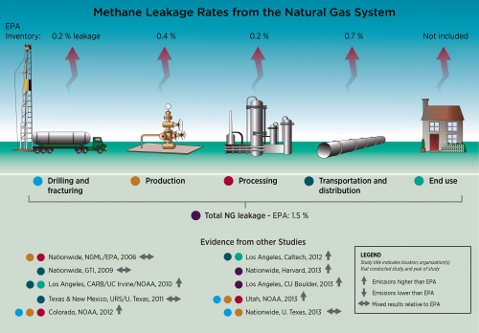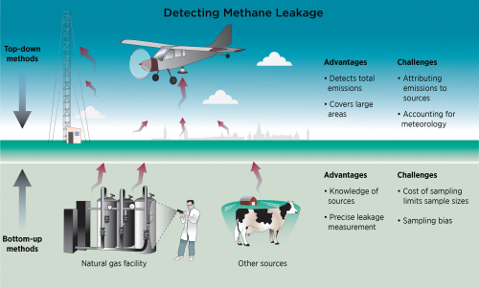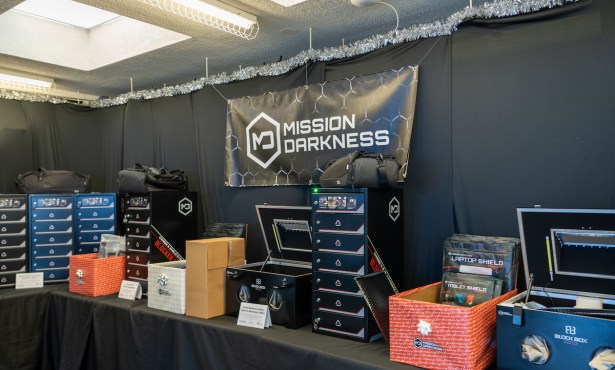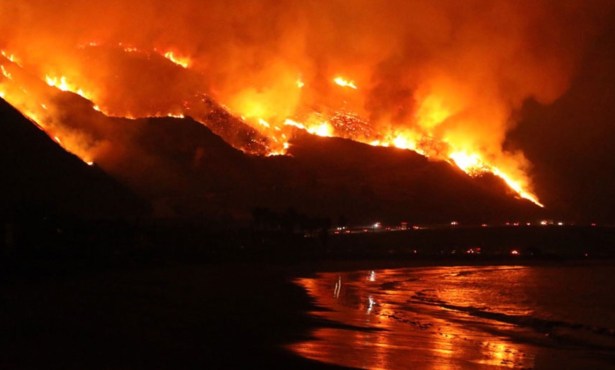More Methane Leaks Than Projected
America's Leaky Natural Gas System Needs a Fix

The first thorough comparison of evidence for natural gas system leaks confirms that organizations, including the Environmental Protection Agency (EPA), have underestimated methane emissions in the United States generally and those from the natural gas industry specifically. The review, published in the February 14 issue of the journal Science, synthesizes diverse findings from more than 200 studies ranging in scope from local gas processing plants to total emissions from the United States and Canada.
Natural gas consists predominantly of methane. Even small leaks from the natural gas system are important because methane is a potent greenhouse gas – about 30 times more potent than carbon dioxide.
“People who go out and actually measure methane pretty consistently find more emissions than we expect,” said lead author Adam Brandt, an assistant professor of energy resources engineering at Stanford University. “Atmospheric tests covering the entire country indicate emissions around 50 percent more than EPA estimates — and that’s a moderate estimate.”
One possible reason leaks in the gas industry have been underestimated is that emission rates for wells and processing plants were based on operators participating voluntarily. One EPA study asked 30 gas companies to cooperate, but only six allowed the EPA on site.

“This study very clearly validates that there is much higher emission than what has been predicted,” says co-author Galen Stucky, a professor in the Department of Chemistry at UC Santa Barbara. “In the end, I’m not too surprised that the inventory did not match actual emissions. The black holes are primarily what are called high emitters, and the big question is exactly where those emissions are coming from?”
The standard approach to estimating total methane emissions is to multiply the amount of methane thought to be emitted by a particular kind of source, such as leaks at natural gas processing plants or belching cattle, by the number of that source type in a region or country. The products are then totaled to estimate all emissions. The EPA does not include natural methane sources such as wetlands and geologic seeps.
The national natural gas infrastructure has a combination of intentional leaks, often for safety purposes, and unintentional emissions, such as faulty valves and cracks in pipelines. Emission rates of particular U.S. gas industry components — from wells to burner tips — were established by the EPA in the 1990s.
Since then, many studies have tested gas industry components to determine whether the EPA’s emission rates are accurate, and a majority of these have found the EPA’s rates too low. The new analysis does not try to attribute percentages of the excess emissions to natural gas, oil, coal, agriculture, landfills, etc., because emission rates for most sources are so uncertain.

Several other studies have used airplanes and towers to measure actual methane in the air in order to test total estimated emissions. The new analysis found these atmospheric studies, which cover very large areas consistently, indicate total U.S. methane emissions are between 25 and 75 percent higher than the EPA estimate.
Some of the difference is accounted for by the EPA’s focus on emissions caused by human activity. However, in addition to excluding natural methane sources, the EPA also omits some emissions caused by human activity, such as abandoned oil and gas wells, because the amounts of associated methane are unknown.
Natural Gas as a Replacement Fuel
Authored by researchers from seven universities, several national laboratories and federal government bodies, and other organizations, the new analysis shows that even though the gas system is almost certainly leakier than previously thought, generating electricity by burning natural gas rather than coal still reduces the total greenhouse effect over 100 years. Not only does burning coal release an enormous amount of carbon dioxide, but mining it releases methane.
Perhaps surprisingly, the analysis finds that powering trucks and buses with natural gas instead of diesel fuel probably makes the globe warmer, because diesel engines are relatively clean. For natural gas to beat diesel, the gas industry would have to be less leaky than the EPA’s current estimate, which the new study determines is improbable.
“Fueling trucks and buses with natural gas may help local air quality and reduce oil imports, but it is not likely to reduce greenhouse gas emissions,” Brandt said. “Even running passenger cars on natural gas instead of gasoline is probably borderline in terms of climate.”
According to the authors’ analysis, the natural gas industry must clean up its leaks to really deliver on its promise of less harm. Fortunately for gas companies, a few leaks in the gas system probably account for much of the problem and could be repaired. One earlier study examined about 75,000 components at processing plants. It found some 1,600 unintentional leaks, but just 50 faulty components, were behind 60 percent of the leaked gas.
“If you look at how energy is used, there is a huge amount of it that’s wasted,” Stucky said. “What needs to be done is to better identify the discrepancies between our invoices and what we actually observe in the atmosphere. Our analysis identifies the problem, and that is an important first step.”
Other co-authors are Garvin Heath, a senior scientist at the National Renewable Energy Laboratory; Eric Kort, an atmospheric science professor at the University of Michigan; Francis O’Sullivan of the MIT Energy Initiative; Gabrielle Pétron of the National Oceanic and Atmospheric Administration (NOAA) and the University of Colorado; Sarah M. Jordaan of the University of Calgary; Pieter Tans of NOAA; Jennifer Wilcox of Stanford University; Avi Gopstein of the U.S. Department of State; Doug Arent of the National Renewable Energy Laboratory and the Joint Institute for Strategic Energy Analysis; Steven Wofsy of Harvard University; Nancy Brown of the Lawrence Berkeley National Laboratory; independent consultant Richard Bradley; Douglas Eardley of the University of California-Santa Barbara; and Robert Harriss, a methane researcher at the Environmental Defense Fund.
The research was funded by the nonprofit organization Novim through a grant from the Cynthia and George Mitchell Foundation.



